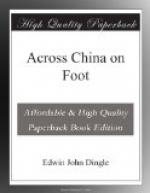I am of the opinion that the Li-su may be closely allied to the Lolo or the Nou Su, of whom I have spoken in the chapters in Book I dealing with the tribes around Chao-t’ong. And even the Miao bear a distinct racial resemblance. They are of bony physique, high cheek bones, and their skin is nearly of the same almost sepia color. The Li-su form practically the whole of the population of the Upper Salwen Valley from about lat. 25 deg. 30’ to 27 deg. 30’, and they have spread in considerable numbers along the mountains between the Shweli and the Irawadi, and are found also in the Shan States. Those on the Upper Salwen in the extreme north are utter savages, but where they have become more or less civilized have shown themselves to be an enterprising race in the way of emigration. Of the savages, the villages are almost always at war with one another, and many have never been farther from their huts than a day’s march will take them, the chief object of their lives being apparently to keep their neighbors at a distance. They are exceedingly lazy. They spend their lives doing as little in the way of work as they must, eating, drinking, squatting about round the hearth telling stories of their valor with the cross-bow, and their excitement is provided by an occasional expedition to get wood for their cross-bows and poison for their arrows, or a stock of salt and wild honey.
Mr. Forrest, in his paper which was read before the Royal Geographical Society in June, 1908, speaks of this wild honey as an agreeable sweetmeat as a change, but that after a few days’ constant partaking of it the European palate rejects it as nauseous and almost disgusting, and adds that it has escaped the Biblical commentators that one of the principal hardships which John the Baptist must have undergone was his diet of wild honey. In another part of his paper the writer says, speaking of the cross-bow to which I have referred: “Every Li-su with any pretensions to chic possesses at least one of these weapons—one for everyday use in hunting, the other for war. The children play with miniature cross-bows. The men never leave their huts for any purpose without their cross-bows, when they go to sleep the ‘na-kung’ is hung over their heads, and when they die it is hung over their graves. The largest cross-bows have a span of fully five feet, and require a pull of thirty-five pounds to string them. The bow is made of a species of wild mulberry, of great toughness and flexibility. The stock, some four feet long in the war-bows, is usually of wild plum wood, the string is of plaited hemp, and the trigger of bone. The arrow, of sixteen to eighteen inches, is of split bamboo, about four times the thickness of an ordinary knitting needle, hardened and pointed. The actual point is bare for a quarter to one-third of an inch, then for fully an inch the arrow is stripped to half its thickness, and on this portion the poison is placed. The poison used is invariably a decoction expressed from the tubers




